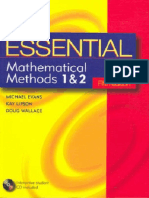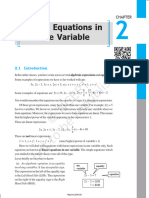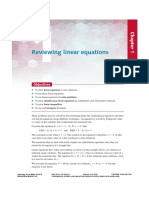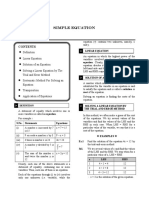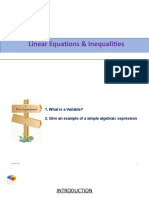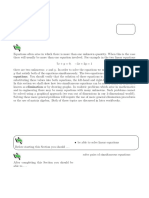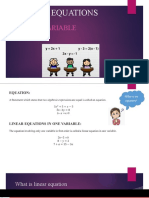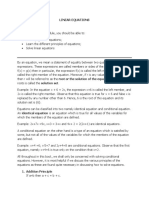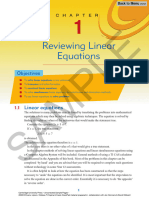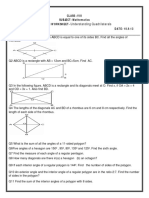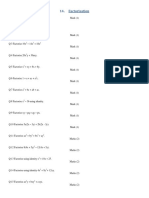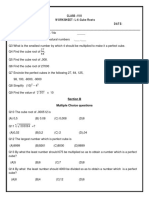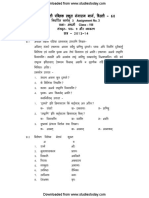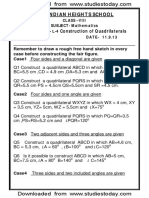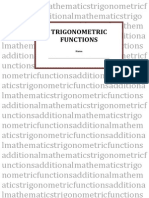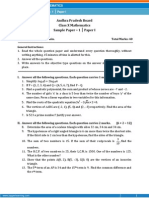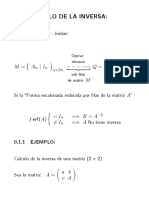NCERT Class 8 Maths Linear Equations in One Variable
NCERT Class 8 Maths Linear Equations in One Variable
Uploaded by
sanaCopyright:
Available Formats
NCERT Class 8 Maths Linear Equations in One Variable
NCERT Class 8 Maths Linear Equations in One Variable
Uploaded by
sanaCopyright
Available Formats
Share this document
Did you find this document useful?
Is this content inappropriate?
Copyright:
Available Formats
NCERT Class 8 Maths Linear Equations in One Variable
NCERT Class 8 Maths Linear Equations in One Variable
Uploaded by
sanaCopyright:
Available Formats
Downloaded from https:// www.studiestoday.
com
LINEAR EQUATIONS IN ONE VARIABLE 21
CHAPTER
Linear Equations in
One Variable
2
2.1 Introduction
In the earlier classes, you have come across several algebraic expressions and equations.
Some examples of expressions we have so far worked with are:
5x, 2x – 3, 3x + y, 2xy + 5, xyz + x + y + z, x2 + 1, y + y2
5 37
Some examples of equations are: 5x = 25, 2x – 3 = 9, 2 y + = , 6 z + 10 = −2
2 2
You would remember that equations use the equality (=) sign; it is missing in expressions.
Of these given expressions, many have more than one variable. For example, 2xy + 5
has two variables. We however, restrict to expressions with only one variable when we
form equations. Moreover, the expressions we use to form equations are linear. This means
that the highest power of the variable appearing in the expression is 1.
These are linear expressions:
5
2x, 2x + 1, 3y – 7, 12 – 5z, ( x – 4) + 10
4
These are not linear expressions:
x2 + 1, y + y2, 1 + z + z2 + z3 (since highest power of variable > 1)
Here we will deal with equations with linear expressions in one variable only. Such
equations are known as linear equations in one variable. The simple equations which
you studied in the earlier classes were all of this type.
Let us briefly revise what we know:
(a) An algebraic equation is an equality
involving variables. It has an equality sign.
The expression on the left of the equality sign 2x – 3 = 7
is the Left Hand Side (LHS). The expression
2x – 3 = LHS
on the right of the equality sign is the Right 7 = RHS
Hand Side (RHS).
2019-20
Downloaded from https:// www.studiestoday.com
Downloaded from https:// www.studiestoday.com
22 MATHEMATICS
(b) In an equation the values of x = 5 is the solution of the equation
the expressions on the LHS 2x – 3 = 7. For x = 5,
and RHS are equal. This LHS = 2 × 5 – 3 = 7 = RHS
happens to be true only for On the other hand x = 10 is not a solution of the
certain values of the variable. equation. For x = 10, LHS = 2 × 10 – 3 = 17.
These values are the This is not equal to the RHS
solutions of the equation.
(c) How to find the solution of an equation?
We assume that the two sides of the equation are balanced.
We perform the same mathematical operations on both
sides of the equation, so that the balance is not disturbed.
A few such steps give the solution.
2.2 Solving Equations which have Linear Expressions
on one Side and Numbers on the other Side
Let us recall the technique of solving equations with some examples. Observe the solutions;
they can be any rational number.
Example 1: Find the solution of 2x – 3 = 7
Solution:
Step 1 Add 3 to both sides.
2x – 3 + 3 = 7 + 3 (The balance is not disturbed)
or 2x = 10
Step 2 Next divide both sides by 2.
2 x 10
=
2 2
or x=5 (required solution)
Example 2: Solve 2y + 9 = 4
Solution: Transposing 9 to RHS
2y = 4 – 9
or 2y = – 5
−5
Dividing both sides by 2, y= (solution)
2
−5
To check the answer: LHS = 2 + 9 = – 5 + 9 = 4 = RHS (as required)
2
−5
Do you notice that the solution is a rational number? In Class VII, the equations
2
we solved did not have such solutions.
2019-20
Downloaded from https:// www.studiestoday.com
Downloaded from https:// www.studiestoday.com
LINEAR EQUATIONS IN ONE VARIABLE 23
x 5 3
Example 3: Solve + =−
3 2 2
5 x −3 5 8
Solution: Transposing to the RHS, we get = − =−
2 3 2 2 2
x
or =–4
3
Multiply both sides by 3, x=–4×3
or x = – 12 (solution)
12 5 5 −8 + 5 −3
Check: LHS = − + = − 4+ = = = RHS (as required)
3 2 2 2 2
Do you now see that the coefficient of a variable in an equation need not be an integer?
15
Example 4: Solve – 7x = 9
4
15
Solution: We have – 7x = 9
4
15 15
or – 7x = 9 – (transposing to R H S)
4 4
21
or – 7x =
4
21
or x= (dividing both sides by – 7)
4 × (−7)
3× 7
or x= −
4×7
3
or x= − (solution)
4
15 −3 15 21 36
Check: LHS = −7 = + = = 9 = RHS (as required)
4 4 4 4 4
EXERCISE 2.1
Solve the following equations.
1. x – 2 = 7 2. y + 3 = 10 3. 6 = z + 2
3 17 t
4. + x= 5. 6x = 12 6. = 10
7 7 5
2x y
7. = 18 8. 1.6 = 9. 7x – 9 = 16
3 1.5
2019-20
Downloaded from https:// www.studiestoday.com
Downloaded from https:// www.studiestoday.com
24 MATHEMATICS
x 7
10. 14y – 8 = 13 11. 17 + 6p = 9 12. +1=
3 15
2.3 Some Applications
We begin with a simple example.
Sum of two numbers is 74. One of the numbers is 10 more than the other. What are the
numbers?
We have a puzzle here. We do not know either of the two numbers, and we have to
find them. We are given two conditions.
(i) One of the numbers is 10 more than the other.
(ii) Their sum is 74.
We already know from Class VII how to proceed. If the smaller number is taken to
be x, the larger number is 10 more than x, i.e., x + 10. The other condition says that
the sum of these two numbers x and x + 10 is 74.
This means that x + (x + 10) = 74.
or 2x + 10 = 74
Transposing 10 to RHS, 2x = 74 – 10
or 2x = 64
Dividing both sides by 2, x = 32. This is one number.
The other number is x + 10 = 32 + 10 = 42
The desired numbers are 32 and 42. (Their sum is indeed 74 as given and also one
number is 10 more than the other.)
We shall now consider several examples to show how useful this method is.
−7 3
Example 5: What should be added to twice the rational number to get ?
3 7
−7 −7 −14
Solution: Twice the rational number is 2 × = . Suppose x added to this
3 3 3
3
number gives ; i.e.,
7
−14 3
x+
3 = 7
14 3
or x− =
3 7
3 14 14
or x= + (transposing to RHS)
7 3 3
(3 × 3) + (14 × 7) 9 + 98 107
= = = .
21 21 21
2019-20
Downloaded from https:// www.studiestoday.com
Downloaded from https:// www.studiestoday.com
LINEAR EQUATIONS IN ONE VARIABLE 25
107 −7 3
Thus should be added to 2 × to give .
21 3 7
3
Example 6: The perimeter of a rectangle is 13 cm and its width is 2 cm. Find its
4
length.
Solution: Assume the length of the rectangle to be x cm.
The perimeter of the rectangle = 2 × (length + width)
3
= 2 × (x + 2 )
4
11
= 2 x +
4
The perimeter is given to be 13 cm. Therefore,
11
2 x + = 13
4
11 13
or x+ = (dividing both sides by 2)
4 2
13 11
or x= −
2 4
26 11 15 3
= − = =3
4 4 4 4
3
The length of the rectangle is 3 cm.
4
Example 7: The present age of Sahil’s mother is three times the present age of Sahil.
After 5 years their ages will add to 66 years. Find their present ages.
Solution: Let Sahil’s present age be x years.
We could also choose Sahil’s age Sahil Mother Sum
5 years later to be x and proceed.
Present age x 3x
Why don’t you try it that way?
Age 5 years later x+5 3x + 5 4x + 10
It is given that this sum is 66 years.
Therefore, 4x + 10 = 66
This equation determines Sahil’s present age which is x years. To solve the equation,
2019-20
Downloaded from https:// www.studiestoday.com
Downloaded from https:// www.studiestoday.com
26 MATHEMATICS
we transpose 10 to RHS,
4x = 66 – 10
or 4x = 56
56
or x= = 14 (solution)
4
Thus, Sahil’s present age is 14 years and his mother’s age is 42 years. (You may easily
check that 5 years from now the sum of their ages will be 66 years.)
Example 8: Bansi has 3 times as many two-rupee coins as he has five-rupee coins. If
he has in all a sum of ` 77, how many coins of each denomination does he have?
Solution: Let the number of five-rupee coins that Bansi has be x. Then the number of
two-rupee coins he has is 3 times x or 3x.
The amount Bansi has:
(i) from 5 rupee coins, ` 5 × x = ` 5x
(ii) from 2 rupee coins, ` 2 × 3x = ` 6x
Rs 2
Hence the total money he has = ` 11x Rs 5
But this is given to be ` 77; therefore,
11x = 77
77
or x= =7
11
Thus, number of five-rupee coins = x = 7
and number of two-rupee coins = 3x = 21 (solution)
(You can check that the total money with Bansi is ` 77.)
Example 9: The sum of three consecutive multiples of 11 is 363. Find these
multiples.
Solution: If x is a multiple of 11, the next multiple is x + 11. The next to this is
x + 11 + 11 or x + 22. So we can take three consecutive multiples of 11 as x, x + 11 and
x + 22.
It is given that the sum of these consecutive
multiples of 11 is 363. This will give the Alternatively, we may think of the multiple
following equation: of 11 immediately before x. This is (x – 11).
x + (x + 11) + (x + 22) = 363 Therefore, we may take three consecutive
multiples of 11 as x – 11, x, x + 11.
or x + x + 11 + x + 22 = 363
In this case we arrive at the equation
or 3x + 33 = 363
(x – 11) + x + (x + 11) = 363
or 3x = 363 – 33
or 3x = 363
or 3x = 330
2019-20
Downloaded from https:// www.studiestoday.com
Downloaded from https:// www.studiestoday.com
LINEAR EQUATIONS IN ONE VARIABLE 27
330 363
or x= or x= = 121. Therefore,
3 3
= 110 x = 121, x – 11 = 110, x + 11 = 132
Hence, the three consecutive multiples are
Hence, the three consecutive multiples
110, 121, 132.
are 110, 121, 132 (answer).
We can see that we can adopt different ways to find a solution for the problem.
Example 10: The difference between two whole numbers is 66. The ratio of the two
numbers is 2 : 5. What are the two numbers?
Solution: Since the ratio of the two numbers is 2 : 5, we may take one number to be
2x and the other to be 5x. (Note that 2x : 5x is same as 2 : 5.)
The difference between the two numbers is (5x – 2x). It is given that the difference
is 66. Therefore,
5x – 2x = 66
or 3x = 66
or x = 22
Since the numbers are 2x and 5x, they are 2 × 22 or 44 and 5 × 22 or 110, respectively.
The difference between the two numbers is 110 – 44 = 66 as desired.
Example 11: Deveshi has a total of ` 590 as currency notes in the denominations of
` 50, ` 20 and ` 10. The ratio of the number of ` 50 notes and ` 20 notes is 3:5. If she has
a total of 25 notes, how many notes of each denomination she has?
Solution: Let the number of ` 50 notes and ` 20 notes be 3x and 5x, respectively.
But she has 25 notes in total.
Therefore, the number of ` 10 notes = 25 – (3x + 5x) = 25 – 8x
The amount she has
from ` 50 notes : 3x × 50 = ` 150x
from ` 20 notes : 5x × 20 = ` 100x
from ` 10 notes : (25 – 8x) × 10 = ` (250 – 80x)
Hence the total money she has =150x + 100x + (250 – 80x) = ` (170x + 250)
But she has ` 590. Therefore, 170x + 250 = 590
or 170x = 590 – 250 = 340
340
or x= =2
170
The number of ` 50 notes she has = 3x
=3×2=6
The number of ` 20 notes she has = 5x = 5 × 2 = 10
The number of ` 10 notes she has = 25 – 8x
= 25 – (8 × 2) = 25 – 16 = 9
2019-20
Downloaded from https:// www.studiestoday.com
Downloaded from https:// www.studiestoday.com
28 MATHEMATICS
EXERCISE 2.2
1 1 1
1. If you subtract from a number and multiply the result by , you get . What is
2 2 8
the number?
2. The perimeter of a rectangular swimming pool is 154 m. Its length is 2 m more than
twice its breadth. What are the length and the breadth of the pool?
4 2
3. The base of an isosceles triangle is cm . The perimeter of the triangle is 4 cm .
3 15
What is the length of either of the remaining equal sides?
4. Sum of two numbers is 95. If one exceeds the other by 15, find the numbers.
5. Two numbers are in the ratio 5:3. If they differ by 18, what are the numbers?
6. Three consecutive integers add up to 51. What are these integers?
7. The sum of three consecutive multiples of 8 is 888. Find the multiples.
8. Three consecutive integers are such that when they are taken in increasing order and
multiplied by 2, 3 and 4 respectively, they add up to 74. Find these numbers.
9. The ages of Rahul and Haroon are in the ratio 5:7. Four years later the sum of their
ages will be 56 years. What are their present ages?
10. The number of boys and girls in a class are in the ratio 7:5. The number of boys is 8
more than the number of girls. What is the total class strength?
11. Baichung’s father is 26 years younger than Baichung’s grandfather and 29 years
older than Baichung. The sum of the ages of all the three is 135 years. What is the
age of each one of them?
12. Fifteen years from now Ravi’s age will be four times his present age. What is Ravi’s
present age?
5 2
13. A rational number is such that when you multiply it by and add to the product,
2 3
7
you get − . What is the number?
12
14. Lakshmi is a cashier in a bank. She has currency notes of denominations
` 100, ` 50 and ` 10, respectively. The ratio of the number of these
notes is 2:3:5. The total cash with Lakshmi is ` 4,00,000. How many
notes of each denomination does she have?
15. I have a total of ` 300 in coins of denomination ` 1, ` 2 and ` 5. The
number of ` 2 coins is 3 times the number of ` 5 coins. The total number of
coins is 160. How many coins of each denomination are with me?
16. The organisers of an essay competition decide that a winner in the
competition gets a prize of ` 100 and a participant who does not win gets
a prize of ` 25. The total prize money distributed is ` 3,000. Find the
number of winners, if the total number of participants is 63.
2019-20
Downloaded from https:// www.studiestoday.com
Downloaded from https:// www.studiestoday.com
LINEAR EQUATIONS IN ONE VARIABLE 29
2.4 Solving Equations having the Variable on
both Sides
An equation is the equality of the values of two expressions. In the equation 2x – 3 = 7,
the two expressions are 2x – 3 and 7. In most examples that we have come across so
far, the RHS is just a number. But this need not always be so; both sides could have
expressions with variables. For example, the equation 2x – 3 = x + 2 has expressions
with a variable on both sides; the expression on the LHS is (2x – 3) and the expression
on the RHS is (x + 2).
• We now discuss how to solve such equations which have expressions with the variable
on both sides.
Example 12: Solve 2x – 3 = x + 2
Solution: We have
2x = x + 2 + 3
or 2x = x + 5
or 2x – x = x + 5 – x (subtracting x from both sides)
or x =5 (solution)
Here we subtracted from both sides of the equation, not a number (constant), but a
term involving the variable. We can do this as variables are also numbers. Also, note that
subtracting x from both sides amounts to transposing x to LHS.
7 3
Example 13: Solve 5x + = x − 14
2 2
Solution: Multiply both sides of the equation by 2. We get
7 3
2 × 5x + = 2 × x − 14
2 2
7 3
(2 × 5x) + 2 × = 2 × x − (2 × 14)
2 2
or 10x + 7 = 3x – 28
or 10x – 3x + 7 = – 28 (transposing 3x to LHS)
or 7x + 7 = – 28
or 7x = – 28 – 7
or 7x = – 35
−35
or x= or x =–5 (solution)
7
2019-20
Downloaded from https:// www.studiestoday.com
Downloaded from https:// www.studiestoday.com
30 MATHEMATICS
EXERCISE 2.3
Solve the following equations and check your results.
1. 3x = 2x + 18 2. 5t – 3 = 3t – 5 3. 5x + 9 = 5 + 3x
4. 4z + 3 = 6 + 2z 5. 2x – 1 = 14 – x 6. 8x + 4 = 3 (x – 1) + 7
4 2x 7x 5 26
7. x = (x + 10) 8. +1= +3 9. 2y + = −y
5 3 15 3 3
8
10. 3m = 5 m –
5
2.5 Some More Applications
Example 14: The digits of a two-digit number differ by 3. If the digits are interchanged,
and the resulting number is added to the original number, we get 143. What can be the
original number?
Solution: Take, for example, a two-digit number, say, 56. It can be written as
56 = (10 × 5) + 6.
If the digits in 56 are interchanged, we get 65, which can be written as (10 × 6 ) + 5.
Let us take the two digit number such that the digit in the units place is b. The digit
in the tens place differs from b by 3. Let us take it as b + 3. So the two-digit number
is 10 (b + 3) + b = 10b + 30 + b = 11b + 30.
Could we take the tens
With interchange of digits, the resulting two-digit number will be place digit to be
10b + (b + 3) = 11b + 3 (b – 3)? Try it and see
what solution you get.
If we add these two two-digit numbers, their sum is
(11b + 30) + (11b + 3) = 11b + 11b + 30 + 3 = 22b + 33
It is given that the sum is 143. Therefore, 22b + 33 = 143
or 22b = 143 – 33
Remember, this is the solution
or 22b = 110 when we choose the tens digits to
be 3 more than the unit’s digits.
110 What happens if we take the tens
or b= digit to be (b – 3)?
22
or b=5
The units digit is 5 and therefore the tens digit is 5 + 3 The statement of the
which is 8. The number is 85. example is valid for both 58
and 85 and both are correct
Check: On interchange of digits the number we get is answers.
58. The sum of 85 and 58 is 143 as given.
2019-20
Downloaded from https:// www.studiestoday.com
Downloaded from https:// www.studiestoday.com
LINEAR EQUATIONS IN ONE VARIABLE 31
Example 15: Arjun is twice as old as Shriya. Five years ago his age was three times
Shriya’s age. Find their present ages.
Solution: Let us take Shriya’s present age to be x years.
Then Arjun’s present age would be 2x years.
Shriya’s age five years ago was (x – 5) years.
Arjun’s age five years ago was (2x – 5) years.
It is given that Arjun’s age five years ago was three times Shriya’s age.
Thus, 2x – 5 = 3(x – 5)
or 2x – 5 = 3x – 15
or 15 – 5 = 3x – 2x
or 10 = x
So, Shriya’s present age = x = 10 years.
Therefore, Arjun’s present age = 2x = 2 × 10 = 20 years.
EXERCISE 2.4
5
1. Amina thinks of a number and subtracts from it. She multiplies the result by 8. The
2
result now obtained is 3 times the same number she thought of. What is the number?
2. A positive number is 5 times another number. If 21 is added to both the numbers,
then one of the new numbers becomes twice the other new number. What are the
numbers?
3. Sum of the digits of a two-digit number is 9. When we interchange the digits, it is
found that the resulting new number is greater than the original number by 27. What
is the two-digit number?
4. One of the two digits of a two digit number is three times the other digit. If you
interchange the digits of this two-digit number and add the resulting number to the
original number, you get 88. What is the original number?
5. Shobo’s mother’s present age is six times Shobo’s present age. Shobo’s age five
years from now will be one third of his mother’s present age. What are their
present ages?
6. There is a narrow rectangular plot, reserved for a school, in Mahuli village. The
length and breadth of the plot are in the ratio 11:4. At the rate `100 per metre it will
cost the village panchayat ` 75000 to fence the plot. What are the dimensions of
the plot?
7. Hasan buys two kinds of cloth materials for school uniforms, shirt material that
costs him ` 50 per metre and trouser material that costs him ` 90 per metre.
2019-20
Downloaded from https:// www.studiestoday.com
Downloaded from https:// www.studiestoday.com
32 MATHEMATICS
For every 3 meters of the shirt material he buys 2 metres
of the trouser material. He sells the materials at 12%
and 10% profit respectively. His total sale is ` 36,600.
How much trouser material did he buy?
8. Half of a herd of deer are grazing in the field and three
fourths of the remaining are playing nearby. The rest 9
are drinking water from the pond. Find the number of
deer in the herd.
9. A grandfather is ten times older than his granddaughter.
He is also 54 years older than her. Find their present ages.
10. Aman’s age is three times his son’s age. Ten years ago he was five times his son’s
age. Find their present ages.
2.6 Reducing Equations to Simpler Form
6x + 1 x −3
Example 16: Solve +1 =
3 6
Solution: Multiplying both sides of the equation by 6, Why 6? Because it is the
6 (6 x + 1) 6( x − 3) smallest multiple (or LCM)
+ 6 ×1 = of the given denominators.
3 6
or 2 (6x + 1) + 6 = x – 3
or 12x + 2 + 6 = x – 3 (opening the brackets )
or 12x + 8 = x – 3
or 12x – x + 8 = – 3
or 11x + 8 = – 3
or 11x = –3 – 8
or 11x = –11
or x=–1 (required solution)
6( −1) + 1 −6 + 1 −5 3 −5 + 3 −2
Check: LHS = +1 = +1 = + = =
3 3 3 3 3 3
( −1) − 3 −4 −2
RHS = = =
6 6 3
LHS = RHS. (as required)
7
Example 17: Solve 5x – 2 (2x – 7) = 2 (3x – 1) +
2
Solution: Let us open the brackets,
LHS = 5x – 4x + 14 = x + 14
2019-20
Downloaded from https:// www.studiestoday.com
Downloaded from https:// www.studiestoday.com
LINEAR EQUATIONS IN ONE VARIABLE 33
7 4 7 3
RHS = 6x – 2 + = 6x − + = 6x +
2 2 2 2
3
The equation is x + 14 = 6x +
2
3
or 14 = 6x – x +
2
3
or 14 = 5x +
2
3 3
or 14 – = 5x (transposing )
2 2
28 − 3
or = 5x
2 Did you observe how we
simplified the form of the given
25 equation? Here, we had to
or = 5x multiply both sides of the
2 equation by the LCM of the
denominators of the terms in the
25 1 5 × 5 5 expressions of the equation.
or x= × = =
2 5 2×5 2
5
Therefore, required solution is x = .
2
Check: LHS =
25 25 25 25 + 8 33
= − 2(5 − 7) = − 2(−2) = +4 = =
2 2 2 2 2
RHS = Note, in this example we
brought the equation to a
simpler form by opening
26 + 7 33 brackets and combining like
= = = LHS. (as required) terms on both sides of the
2 2 equation.
EXERCISE 2.5
Solve the following linear equations.
x 1 x 1 n 3n 5n 8 x 17 5 x
1. − = + 2. − + = 21 3. x + 7 − = −
2 5 3 4 2 4 6 3 6 2
2019-20
Downloaded from https:// www.studiestoday.com
Downloaded from https:// www.studiestoday.com
34 MATHEMATICS
x−5 x−3 3t − 2 2t + 3 2 m −1 m−2
4. = 5. − = −t 6. m − =1−
3 5 4 3 3 2 3
Simplify and solve the following linear equations.
7. 3(t – 3) = 5(2t + 1) 8. 15(y – 4) –2(y – 9) + 5(y + 6) = 0
9. 3(5z – 7) – 2(9z – 11) = 4(8z – 13) – 17
10. 0.25(4f – 3) = 0.05(10f – 9)
2.7 Equations Reducible to the Linear Form
x +1 3
Example 18: Solve =
2x + 3 8
Solution: Observe that the equation is not a linear equation, since the expression on its
LHS is not linear. But we can put it into the form of a linear equation. We multiply both
sides of the equation by (2x + 3),
x +1 3 Note that
2 x + 3 × (2 x + 3) = × (2 x + 3) 2x + 3 ≠ 0 (Why?)
8
Notice that (2x + 3) gets cancelled on the LHS We have then,
3 (2 x + 3)
x+1=
8
We have now a linear equation which we know how to solve.
Multiplying both sides by 8
8 (x + 1) = 3 (2x + 3) This step can be
or 8x + 8 = 6x + 9 directly obtained by
‘cross-multiplication’
or 8x = 6x + 9 – 8
or 8x = 6x + 1
or 8x – 6x = 1
or 2x = 1
1
or x=
2
1
The solution is x = .
2
1 1+ 2 3
Check : Numerator of LHS = +1= =
2 2 2
1
Denominator of LHS = 2x + 3 = 2 × +3=1+3=4
2
2019-20
Downloaded from https:// www.studiestoday.com
Downloaded from https:// www.studiestoday.com
LINEAR EQUATIONS IN ONE VARIABLE 35
3 3 1 3
LHS = numerator ÷ denominator = ÷4= × =
2 2 4 8
LHS = RHS.
Example 19: Present ages of Anu and Raj are in the ratio 4:5. Eight years from now
the ratio of their ages will be 5:6. Find their present ages.
Solution: Let the present ages of Anu and Raj be 4x years and 5x years respectively.
After eight years. Anu’s age = (4x + 8) years;
After eight years, Raj’s age = (5x + 8) years.
4x + 8
Therefore, the ratio of their ages after eight years =
5x + 8
This is given to be 5 : 6
4x + 8 5
Therefore, =
5x + 8 6
Cross-multiplication gives 6 (4x + 8) = 5 (5x + 8)
or 24x + 48 = 25x + 40
or 24x + 48 – 40 = 25x
or 24x + 8 = 25x
or 8 = 25x – 24x
or 8=x
Therefore, Anu’s present age = 4x = 4 × 8 = 32 years
Raj’s present age = 5x = 5 × 8 = 40 years
EXERCISE 2.6
Solve the following equations.
8x − 3 9x z 4
1. =2 2. = 15 3. =
3x 7 − 6x z + 15 9
3 y + 4 −2 7y + 4 − 4
4. = 5. =
2 – 6y 5 y+2 3
6. The ages of Hari and Harry are in the ratio 5:7. Four years from now the ratio of
their ages will be 3:4. Find their present ages.
7. The denominator of a rational number is greater than its numerator by 8. If the
numerator is increased by 17 and the denominator is decreased by 1, the number
3
obtained is . Find the rational number.
2
2019-20
Downloaded from https:// www.studiestoday.com
Downloaded from https:// www.studiestoday.com
36 MATHEMATICS
WHAT HAVE WE DISCUSSED?
1. An algebraic equation is an equality involving variables. It says that the value of the expression on
one side of the equality sign is equal to the value of the expression on the other side.
2. The equations we study in Classes VI, VII and VIII are linear equations in one variable. In such
equations, the expressions which form the equation contain only one variable. Further, the equations
are linear, i.e., the highest power of the variable appearing in the equation is 1.
3. A linear equation may have for its solution any rational number.
4. An equation may have linear expressions on both sides. Equations that we studied in Classes VI
and VII had just a number on one side of the equation.
5. Just as numbers, variables can, also, be transposed from one side of the equation to the other.
6. Occasionally, the expressions forming equations have to be simplified before we can solve them
by usual methods. Some equations may not even be linear to begin with, but they can be brought
to a linear form by multiplying both sides of the equation by a suitable expression.
7. The utility of linear equations is in their diverse applications; different problems on numbers, ages,
perimeters, combination of currency notes, and so on can be solved using linear equations.
2019-20
Downloaded from https:// www.studiestoday.com
You might also like
- Class VIII FOUNDATION & OLYMPIADDocument119 pagesClass VIII FOUNDATION & OLYMPIADResonance Dlpd73% (63)
- Atg Module 3 PDFDocument7 pagesAtg Module 3 PDFShannen MonteroNo ratings yet
- Evans M - Essential Mathematical Methods 1 y 2Document626 pagesEvans M - Essential Mathematical Methods 1 y 2Wichi100% (1)
- Class 6 Social Science Book AnswersDocument120 pagesClass 6 Social Science Book Answerssana100% (4)
- CBSE Class 8 Mathematics Worksheet - Exponents and PowersDocument4 pagesCBSE Class 8 Mathematics Worksheet - Exponents and Powerssana100% (8)
- CBSE Class 8 Cubes and Cube Roots Worksheet PDFDocument3 pagesCBSE Class 8 Cubes and Cube Roots Worksheet PDFsana50% (10)
- 8 Maths NCERT Chapter 2Document6 pages8 Maths NCERT Chapter 2Saurabh yadavNo ratings yet
- Chapter 2Document6 pagesChapter 2Evergreen EnterprisesNo ratings yet
- Class 8 Math TB Chapter 2 Linear Equations and One VariableDocument6 pagesClass 8 Math TB Chapter 2 Linear Equations and One Variable16P3137 VII-INo ratings yet
- Hemh 102Document6 pagesHemh 102adrishjunnazirNo ratings yet
- Vii-Simple EquatiosDocument36 pagesVii-Simple EquatiosSudheer KumarNo ratings yet
- 1705 - Week 7 Lesson Note For Jss3 MathematicsDocument9 pages1705 - Week 7 Lesson Note For Jss3 MathematicsRasheed AhmedNo ratings yet
- State Council of Education Research and Training: Academic Year 2020-21 (Level 2)Document36 pagesState Council of Education Research and Training: Academic Year 2020-21 (Level 2)Monali PNo ratings yet
- Algebra - RevisionDocument35 pagesAlgebra - Revisionmahatabkhan115No ratings yet
- Schools Division of Zamboanga Del Sur: Region IX - Zamboanga Peninsula Dao, Pagadian CityDocument6 pagesSchools Division of Zamboanga Del Sur: Region IX - Zamboanga Peninsula Dao, Pagadian CityDaryl Mutia AlvizNo ratings yet
- CSU - ITU 07104 Lecture 4Document20 pagesCSU - ITU 07104 Lecture 4MAWAZO KADAMHINo ratings yet
- C1.3 Algebra and Functions 3Document56 pagesC1.3 Algebra and Functions 3Han ZhengNo ratings yet
- Week 1-2cahpter I. Linear Algebrasolving Systems of Linear Equations Linear Algebra 1Document17 pagesWeek 1-2cahpter I. Linear Algebrasolving Systems of Linear Equations Linear Algebra 1Shela RamosNo ratings yet
- SAlgTrig3 01 01Document34 pagesSAlgTrig3 01 01Dee PaisenNo ratings yet
- Unit B PDFDocument25 pagesUnit B PDFsanjuNo ratings yet
- Simple Equations NotesDocument3 pagesSimple Equations NotesMidhun Bhuvanesh.B 7ANo ratings yet
- (E-Module) Math - Ch2 - Linear Equations in One VariableDocument33 pages(E-Module) Math - Ch2 - Linear Equations in One VariableAryan SinghNo ratings yet
- Systems of EquationsDocument51 pagesSystems of Equationsadampau1974No ratings yet
- Mathematical Methods Units 1 2 AC VCE - Chapter 1Document32 pagesMathematical Methods Units 1 2 AC VCE - Chapter 1lequanplus100% (1)
- Maths MethodsDocument32 pagesMaths MethodsSiennaNo ratings yet
- Linear EquationsDocument17 pagesLinear Equationssostine wakoliNo ratings yet
- MathsDocument9 pagesMathsRangeNo ratings yet
- 1-1 MAT 124 - Test 1 Week 1 Solving Equations, Inequalities, AbsoluteDocument5 pages1-1 MAT 124 - Test 1 Week 1 Solving Equations, Inequalities, AbsoluteryleighlapkaNo ratings yet
- Day 2-Notes OrthopDocument86 pagesDay 2-Notes OrthoprutarevNo ratings yet
- Entering Grade 9 Algebra Summer Packet 2020Document7 pagesEntering Grade 9 Algebra Summer Packet 2020jwkong09No ratings yet
- Intermediate Algebra: Gregg Waterman Oregon Institute of TechnologyDocument28 pagesIntermediate Algebra: Gregg Waterman Oregon Institute of TechnologyEdu TrueNo ratings yet
- DLP MathDocument4 pagesDLP MathPatzAlzateParaguyaNo ratings yet
- 3 - Algebra II Business Maths Unit 3Document62 pages3 - Algebra II Business Maths Unit 3Boom SquadNo ratings yet
- Linear Equations and InequalitiesDocument47 pagesLinear Equations and InequalitiesSishira PattanNo ratings yet
- LAS TemplateDocument8 pagesLAS TemplateElon MoskNo ratings yet
- 3 4 SLV Sim Lin EqnsDocument7 pages3 4 SLV Sim Lin EqnsMNo ratings yet
- 5 - EQN1 - 2021 - 9th EdDocument54 pages5 - EQN1 - 2021 - 9th EdTulika SinghNo ratings yet
- Linear Equation and Inequality PDFDocument11 pagesLinear Equation and Inequality PDFMd. Shariful IslamNo ratings yet
- 2) Linear EquationsDocument29 pages2) Linear EquationsJack FosterNo ratings yet
- 1 Linear Equations With and Without Fractions (Key)Document5 pages1 Linear Equations With and Without Fractions (Key)qasem varzidehNo ratings yet
- JSS 3 Online 1Document2 pagesJSS 3 Online 1Oluwadara MabewejeNo ratings yet
- Equations Tranformable To Quadratic EquationsDocument6 pagesEquations Tranformable To Quadratic EquationsLiomer Zabala-Mubo CredoNo ratings yet
- Linear Equations: in One VariableDocument31 pagesLinear Equations: in One VariablePradhosh On AirNo ratings yet
- Simultaneous EquationsDocument6 pagesSimultaneous EquationsAbdur RafayNo ratings yet
- Linear EquationsDocument4 pagesLinear EquationsminaricanoNo ratings yet
- 1.3 General Linear EquationsDocument8 pages1.3 General Linear EquationsExcylefrey OyaNo ratings yet
- 08.30.2019 Linear Equations With One Variable Algebra IaDocument12 pages08.30.2019 Linear Equations With One Variable Algebra Iajyln aaieNo ratings yet
- GM Mod 2Document17 pagesGM Mod 2Alessandra Marie PlatonNo ratings yet
- At The End of The Lesson, The Student Should Be Able ToDocument8 pagesAt The End of The Lesson, The Student Should Be Able ToRisha PascualNo ratings yet
- Chapter 1Document28 pagesChapter 1DNo ratings yet
- Bridging The Gap Between iGCSE and A Level Maths PDFDocument59 pagesBridging The Gap Between iGCSE and A Level Maths PDFSalmuel SmithNo ratings yet
- C 10 Linear EquationsDocument32 pagesC 10 Linear Equationsdaniel.saleib101No ratings yet
- B1 Lesson 8Document14 pagesB1 Lesson 8Montes Arianne A.No ratings yet
- 01 Linear EquationsDocument12 pages01 Linear EquationsDivyaNo ratings yet
- Solve Linear EquationsDocument10 pagesSolve Linear EquationsGear Arellano IINo ratings yet
- Linear Equation in One VariableDocument2 pagesLinear Equation in One VariableDanilo de MesaNo ratings yet
- Systems of EquationsDocument4 pagesSystems of EquationsKeri-ann MillarNo ratings yet
- MATHALGIU02Expressions InequalitiesDocument16 pagesMATHALGIU02Expressions InequalitiesLiam OkkersNo ratings yet
- Ncert Solutions For Class 7 Maths 5may Chapter 4 Simple EquationsDocument44 pagesNcert Solutions For Class 7 Maths 5may Chapter 4 Simple EquationsDurba RayNo ratings yet
- Simple Equations: Free Distribution by A.P. GovernmentDocument10 pagesSimple Equations: Free Distribution by A.P. GovernmentRAJOLI GIRISAI MADHAVNo ratings yet
- ALGEBRA SIMPLIFIED EQUATIONS WORKBOOK WITH ANSWERS: Linear Equations, Quadratic Equations, Systems of EquationsFrom EverandALGEBRA SIMPLIFIED EQUATIONS WORKBOOK WITH ANSWERS: Linear Equations, Quadratic Equations, Systems of EquationsNo ratings yet
- A-level Maths Revision: Cheeky Revision ShortcutsFrom EverandA-level Maths Revision: Cheeky Revision ShortcutsRating: 3.5 out of 5 stars3.5/5 (8)
- Hindi Class 6Document80 pagesHindi Class 6sanaNo ratings yet
- Class 6 SanskritDocument21 pagesClass 6 SanskritsanaNo ratings yet
- CBSE Class 6 Hindi Worksheet PDFDocument2 pagesCBSE Class 6 Hindi Worksheet PDFsanaNo ratings yet
- Food: Where Does It Come From ?: Worksheet-1Document77 pagesFood: Where Does It Come From ?: Worksheet-1sanaNo ratings yet
- CBSE Class 8 Mathematics Worksheet - Understanding QuadrilateralsDocument1 pageCBSE Class 8 Mathematics Worksheet - Understanding Quadrilateralssana0% (1)
- CBSE Class 6 General Knowledge PDFDocument1 pageCBSE Class 6 General Knowledge PDFsanaNo ratings yet
- CBSE Class 8 Mathematics Worksheet - FactorisationDocument4 pagesCBSE Class 8 Mathematics Worksheet - Factorisationsana67% (3)
- CBSE Class 6 General Knowledge PDFDocument1 pageCBSE Class 6 General Knowledge PDFsanaNo ratings yet
- CBSE Class 8 Mathematics Worksheet - Linear Equations in One Variable PDFDocument6 pagesCBSE Class 8 Mathematics Worksheet - Linear Equations in One Variable PDFsana75% (4)
- CBSE Class 6 Hindi Worksheet PDFDocument2 pagesCBSE Class 6 Hindi Worksheet PDFsanaNo ratings yet
- CBSE Class 3 All Subjects Practice Worksheet PDFDocument11 pagesCBSE Class 3 All Subjects Practice Worksheet PDFsanaNo ratings yet
- CBSE Class 9 Arabic AssignmentDocument1 pageCBSE Class 9 Arabic AssignmentsanaNo ratings yet
- CBSE Class 8 Practical Geometry Assignment 1Document1 pageCBSE Class 8 Practical Geometry Assignment 1sanaNo ratings yet
- CBSE Class 8 Mathematics Worksheet - MensurationDocument9 pagesCBSE Class 8 Mathematics Worksheet - Mensurationsana40% (5)
- CBSE Class 8 Mathematics Worksheet - Direct and Inverse ProportionsDocument4 pagesCBSE Class 8 Mathematics Worksheet - Direct and Inverse Proportionssana100% (3)
- CBSE Class 8 Mathematics Ptactice WorksheetDocument2 pagesCBSE Class 8 Mathematics Ptactice WorksheetsanaNo ratings yet
- CBSE Class 8 Mathematics Ptactice WorksheetDocument2 pagesCBSE Class 8 Mathematics Ptactice WorksheetsanaNo ratings yet
- CBSE Class 8 Mathematics Worksheet - Direct and Inverse VariationsDocument3 pagesCBSE Class 8 Mathematics Worksheet - Direct and Inverse Variationssana100% (10)
- CBSE Class 8 Mathematics Worksheet - Construction of Quadrilaterals PDFDocument2 pagesCBSE Class 8 Mathematics Worksheet - Construction of Quadrilaterals PDFsana100% (3)
- Construction of Quadrilaterals: Class VIII. Maths WorksheetDocument2 pagesConstruction of Quadrilaterals: Class VIII. Maths WorksheetsanaNo ratings yet
- CBSE Class 8 Mathematics Worksheet - CuberootsDocument2 pagesCBSE Class 8 Mathematics Worksheet - Cuberootssana100% (3)
- CBSE Class 8 Mathematics Worksheet - Understanding QuadrilateralsDocument15 pagesCBSE Class 8 Mathematics Worksheet - Understanding Quadrilateralssana100% (1)
- CBSE Class 8 Sanskrit WorksheetDocument2 pagesCBSE Class 8 Sanskrit Worksheetsana100% (2)
- CBSE Class 8 Sanskrit Worksheet PDFDocument1 pageCBSE Class 8 Sanskrit Worksheet PDFsanaNo ratings yet
- CBSE Class 8 Mathematics Worksheet - Construction of Quadrilaterals PDFDocument2 pagesCBSE Class 8 Mathematics Worksheet - Construction of Quadrilaterals PDFRitesh SethiaNo ratings yet
- CBSE Class 8 Mathematics Worksheet - Mensuration PDFDocument3 pagesCBSE Class 8 Mathematics Worksheet - Mensuration PDFsana0% (1)
- Lesson 3.3 Finding The Derivative of An Inverse Function-1Document5 pagesLesson 3.3 Finding The Derivative of An Inverse Function-1Hazen D'AuroraNo ratings yet
- RK2 2ndDocument2 pagesRK2 2ndRahulNo ratings yet
- Trigo FunctionsDocument17 pagesTrigo FunctionsNorhapidah Mohd SaadNo ratings yet
- G-8 3rd Summative TestDocument2 pagesG-8 3rd Summative TestJulius Agacid BangeroNo ratings yet
- Complex Analysis With ApplicationsDocument501 pagesComplex Analysis With ApplicationsJaviera San Martín94% (17)
- Mathematics 6 Summative Test - 2 Quarter I. Blacken The Letter of The Correct AnswerDocument2 pagesMathematics 6 Summative Test - 2 Quarter I. Blacken The Letter of The Correct Answercory kurdapyaNo ratings yet
- 33 3Document9 pages33 3karthickNo ratings yet
- Fraction Class 6 PRC Material Rs AggarwalDocument8 pagesFraction Class 6 PRC Material Rs AggarwalYagya DograNo ratings yet
- VECTOR ALGEBRA NotesDocument23 pagesVECTOR ALGEBRA Notesyaashu0707No ratings yet
- Control StructuresDocument34 pagesControl StructuresSunesh SjNo ratings yet
- Numbers System Set - 2Document2 pagesNumbers System Set - 2Harsh singhalNo ratings yet
- Trigonometric Ratios: Opposite & Adjacent Sides in A Right Angled TriangleDocument5 pagesTrigonometric Ratios: Opposite & Adjacent Sides in A Right Angled Trianglesimran kaurNo ratings yet
- 09-Revision Test Advp09-Math-010517Document16 pages09-Revision Test Advp09-Math-010517Aditya AggarwalNo ratings yet
- Kuliah Diff Eq WSDocument172 pagesKuliah Diff Eq WSFerdinand Yesaya NapitupuluNo ratings yet
- GIS Entrance Exam-Math Test (9th Grade) - EnglishDocument6 pagesGIS Entrance Exam-Math Test (9th Grade) - EnglishMikhailWongNo ratings yet
- Jacobian PDFDocument8 pagesJacobian PDFGabriel Antonio Santos BaezNo ratings yet
- ICSE Class 8 Maths Selina Solutions Chapter 15 Linear InequationsDocument5 pagesICSE Class 8 Maths Selina Solutions Chapter 15 Linear InequationsAmmolh MahajanNo ratings yet
- W3 - Lecture 4 XTVTDocument28 pagesW3 - Lecture 4 XTVTHui YuiNo ratings yet
- MATH 20063wk5Document18 pagesMATH 20063wk5Reyziel BarganNo ratings yet
- General Theory of Stochastic ProcessDocument11 pagesGeneral Theory of Stochastic ProcessmemfilmatNo ratings yet
- 18.03SC Differential Equations, Fall 2011 Transcript - Euler's Method AppletDocument3 pages18.03SC Differential Equations, Fall 2011 Transcript - Euler's Method AppletZubayr MoroNo ratings yet
- Evaluating Limits Through Graphs: Lesson 1.2Document36 pagesEvaluating Limits Through Graphs: Lesson 1.2Hannah Gliz PantoNo ratings yet
- Unique Practise Question - MathematicsDocument109 pagesUnique Practise Question - Mathematicszahir khanNo ratings yet
- MATH-8 Q2 Mod1Document14 pagesMATH-8 Q2 Mod1Joshua BaluyotNo ratings yet
- Numerical Sequences. Limit of A Sequence. Properties of Convergent Sequences. Limit of Monotone Sequence. NumberDocument3 pagesNumerical Sequences. Limit of A Sequence. Properties of Convergent Sequences. Limit of Monotone Sequence. NumberFuad SuleymanovNo ratings yet
- AP-Maths Sample Paper-1 For Class 10Document4 pagesAP-Maths Sample Paper-1 For Class 10Firdosh KhanNo ratings yet
- 1950 - Levine, Schwinger - On The Theory of Electromagnetic Wave Diffraction by An Aperture in An Infinite Plane Conducting Screen - Com PDFDocument37 pages1950 - Levine, Schwinger - On The Theory of Electromagnetic Wave Diffraction by An Aperture in An Infinite Plane Conducting Screen - Com PDFClaudio Biagini100% (1)
- 0.1 Calculo de La Inversa:: Metodo de Gauss - JordanDocument20 pages0.1 Calculo de La Inversa:: Metodo de Gauss - JordanCesar ToroNo ratings yet
- Exercise: Section - A (Fixed Response Type) Multiple Choice QuestionsDocument8 pagesExercise: Section - A (Fixed Response Type) Multiple Choice Questionsaayush619_com3918No ratings yet
- StabilityDocument66 pagesStabilityLiying ChewNo ratings yet


